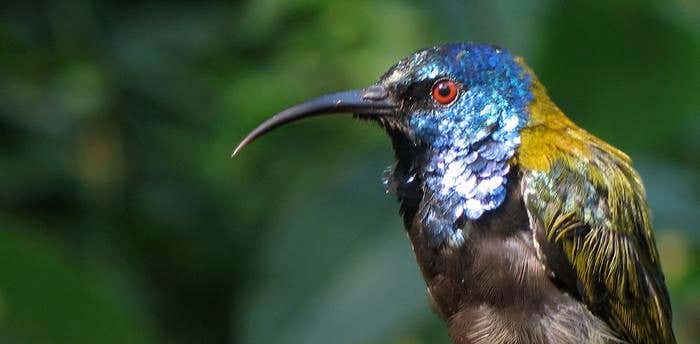Why are tropical birds more colorful than birds from elsewhere?
Researchers found that iridescent, colorful feathers originated over 415 times across the bird family tree, often outside the tropics.

A blue-headed sunbird in the Albertine Rift: an example of a tropical bird with iridescent, colorful feathers. (CREDIT: John Bates, Field Museum)
The colors of birds you see outside your window vary based on your location. Far from the equator, most birds have drab colors. Closer to the tropics, however, you’ll notice more vibrant feathers. Scientists have long wondered why there are more colorful birds in the tropics and how these birds acquired their brilliant hues. Did colorful feathers evolve in the tropics, or did tropical birds inherit their colors from ancestors elsewhere?
A new study in Nature Ecology and Evolution addresses this question. Researchers built a database of 9,409 bird species to examine how color spread globally. They discovered that iridescent feathers originated 415 times across the bird family tree, often outside the tropics. Surprisingly, the ancestor of all modern birds likely had iridescent feathers.
“For decades, scientists have had this hypothesis that there are brighter or more colorful species of birds in the tropics,” says Chad Eliason, a research scientist at the Field Museum in Chicago and the paper’s lead author. “We wanted to find the mechanism to help us understand these trends—how these bright colors got there and how they spread across the bird family tree over time.”
Birds' colors are produced in two main ways: pigments and structures. Pigments like melanin create black and brown colors. Structural color, on the other hand, results from the way light interacts with cell structures, producing effects like iridescence, the rainbow shimmer seen in some birds.
Tropical birds often display a combination of pigments and structural color. Eliason’s research focuses on structural color, so he delved into this aspect of tropical bird coloration. He and his team examined photographs, videos, and scientific illustrations of 9,409 bird species, covering most of the approximately 10,000 known bird species. They noted which species had iridescent feathers and their geographic locations.
The researchers then combined their data on bird coloration and distribution with an existing DNA-based family tree showing bird species relationships. They used a modeling system to determine the origins and spread of iridescence. “Basically, we did a lot of math,” says Eliason.
Related Stories
The modeling software, considering species relationships and locations, along with patterns of species formation and color trait changes over time, concluded that many colorful birds outside the tropics migrated to the region millions of years ago and diversified into numerous species. The model also revealed an unexpected finding about the ancestor of all modern birds.
Birds are specialized dinosaurs. The earliest known bird, Archaeopteryx, lived 140 million years ago. Neornithes, a bird subgroup, evolved 80 million years ago and survived the mass extinction 66 million years ago. All modern birds belong to Neornithes. According to Eliason’s model, the common ancestor of Neornithes had iridescent feathers 80 million years ago, a trait that persists today.
“I was very excited to learn that the ancestral state of all birds is iridescence,” says Eliason. “We’ve found fossil evidence of iridescent birds and other feathered dinosaurs before by examining fossil feathers and their preserved pigment-producing structures. So, we know iridescent feathers existed in the Cretaceous—these fossils support our model’s suggestion that the ancestor of all modern birds was iridescent too.”
This discovery could impact paleontology. ”We’re probably going to be finding a lot more iridescence in the fossil record now that we know to look,” says Eliason.
While this study illuminates how iridescence spread through the bird family tree over millions of years, many questions remain. “We still don’t know why iridescence evolved in the first place,” says Eliason. “Iridescent feathers can attract mates, but they are linked to other aspects of birds’ lives too. For instance, tree swallows change color with humidity, so iridescence might relate to environmental factors or other feather properties like water resistance. Understanding why there are so many iridescent birds in the tropics might help us uncover why iridescence evolved.”
Note: Materials provided above by The Brighter Side of News. Content may be edited for style and length.
Like these kind of feel good stories? Get The Brighter Side of News' newsletter.
Joshua Shavit
Science & Technology Writer | AI and Robotics Reporter
Joshua Shavit is a Los Angeles-based science and technology writer with a passion for exploring the breakthroughs shaping the future. As a contributor to The Brighter Side of News, he focuses on positive and transformative advancements in AI, technology, physics, engineering, robotics and space science. Joshua is currently working towards a Bachelor of Science in Business Administration at the University of California, Berkeley. He combines his academic background with a talent for storytelling, making complex scientific discoveries engaging and accessible. His work highlights the innovators behind the ideas, bringing readers closer to the people driving progress.



